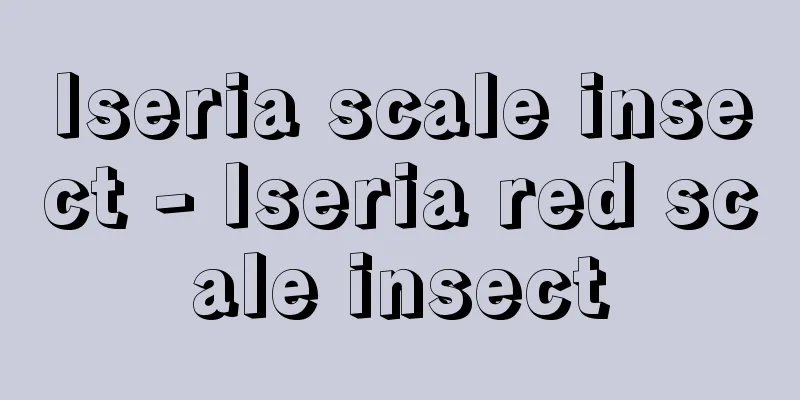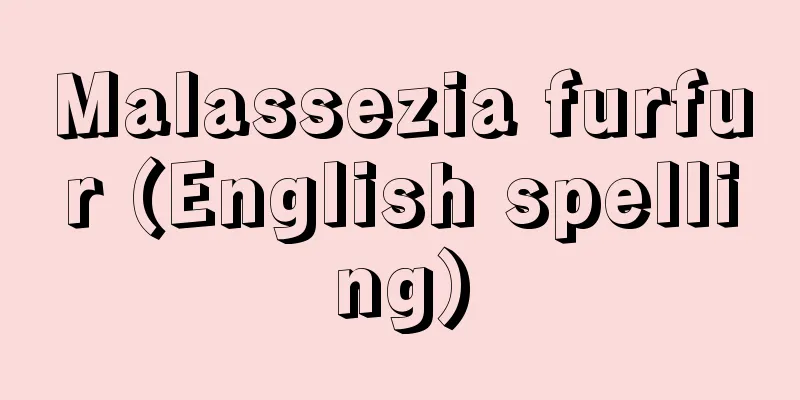Iseria scale insect - Iseria red scale insect

|
... Infested plants suffer direct damage from the sap they suck, and are often weakened by the induction of sooty mold and rot diseases. The host plants vary depending on the species. The Yanone scale, a major pest of citrus, only infests citrus, while the Iseria scale (Icerya purchasi) , the Ruby wax scale (Comstockaspis perniciosa), and the San Jose scale ( Comstockaspis perniciosa ) infest and damage many fruit trees and shrubs. Control with chemicals is difficult, but the use of natural enemies is extremely effective. ... From [Naturalized Species]...Other species that were kept as pets but escaped and became naturalized include the Korean chipmunk, which has become wild in Hokkaido and Kinkazan in Gifu, budgerigars that have become wild around Tokyo, and many other pet birds. Other species that were kept in zoos but escaped and became wild include the Taiwanese squirrel, which is native to Taiwan and lives in Izu Oshima and Kamakura. Among fur animals, there are the nutria, which was imported from Central and South America during World War II and was actively cultivated in various places, but some escaped and became wild in Okayama and other places. There are also the North American muskrat, which is thought to have been cultivated around the same time and has settled near Edogawa in Tokyo, and the North American mink, which was imported as a fur animal after the war, was cultivated, escaped, and became wild in Hokkaido. Furthermore, there are species that are thought to have accidentally entered the country by attaching themselves to imported plants, such as the Iseria scale insect, which was introduced from Australia on ornamental plants at the end of the Meiji period, the Fall Webworm, which is native to North America and was introduced to Japan during World War II, and the green grasshopper, which was introduced from China around the same time. Japan's brown rats, brown rats, and other house mice are thought to have migrated from the continent in ancient times and become wild, but they are not called naturalized animals. *Some of the terminology that refers to "Iseria scale insects" is listed below. Source | Heibonsha World Encyclopedia 2nd Edition | Information |
|
… 寄生をうけた植物は吸汁による直接の被害に加えて,しばしばすす病やこうやく病が誘発されて衰弱する。寄主植物は種によって異なり,ミカンの大害虫ヤノネカイガラムシはミカンにのみ寄生するが,イセリアカイガラムシIcerya purchasiやルビーロウカイガラムシ,サンホーゼカイガラムシComstockaspis perniciosaなどは多くの果樹・植木類に寄生して被害を与える。薬剤による防除はむずかしいが,天敵の利用はきわめて有効である。… 【帰化生物】より…また,愛玩用に飼育していたものが逃げ出して帰化したものに,北海道,岐阜の金華山などに野生化した韓国産のチョウセンシマリス,東京付近などに野生化したセキセイインコその他多数の飼鳥,動物園で飼育していたものが逃げ出して野生化したものに,伊豆大島,鎌倉などにすみついた台湾原産のタイワンリス,毛皮獣では第2次大戦中南アメリカから輸入し,各地で盛んに養殖していたが,その一部が逃げ出し,岡山その他に野生化したヌートリア,同じころ養殖されていたと思われ,東京の江戸川付近に定着している北アメリカ産のマスクラット,戦後毛皮獣として輸入され,養殖されていたものが逃げ出し,北海道で野生化した北アメリカ産のミンクなどがある。さらに,輸入した植物などに付着して偶然に入って来たと思われるものに,明治末に観賞用植物についてオーストラリアから入ってきたイセリアカイガラムシ,第2次大戦中に日本に入った北アメリカ原産のアメリカシロヒトリ,同じころ中国から入ったアオマツムシなどがある。 日本のドブネズミ,クマネズミなどのイエネズミ(家鼠)は古い時代に大陸から渡来して野生化したものと思われるが,これらは帰化動物とは呼ばない。… ※「イセリアカイガラムシ」について言及している用語解説の一部を掲載しています。 出典|株式会社平凡社世界大百科事典 第2版について | 情報 |
<<: Iseriyia scale insect - Iseriyia scale insect
>>: Iseyo doodles - Iseyo doodles
Recommend
Molecular recognition
A biological molecule specifically recognizes and ...
Elephant Idesuzo - Elephant Idesuzo
...The Indian Ganessa elephant S. ganesa and the ...
Thirty-six Immortal Poets
The Thirty-six selected poets by Fujiwara no Kint...
Sosigenes (English spelling)
…As a result, as can be seen from the table, the ...
Dissociation
When a molecule breaks down into smaller or simpl...
allogenic succession
…On the other hand, the influence of the environm...
Kasama ware
A regional brand of Ibaraki Prefecture in the Kant...
Anisic acid - Anis-san (English spelling) anisic acid
Another name for p -methoxybenzoic acid. It is a c...
Submountain area - Asanchitai
… Forest vegetation changes vertically with tempe...
Acidic foods
This refers to foods that have a higher content o...
Allomyces
An aquatic fungus of the Blastocladiales order of ...
Libanius (English spelling)
[Raw] 314 [Death] 393 Greek orator. Born in Antioc...
Music Creation Theory - Ongakusousakuron
…In the Renaissance, composition, which was once ...
Bournonville
Danish dancer and choreographer. Born in Copenhage...
Onikaiopsis - Onikaiopsis
…Also read as Onikaiopsis. A fossil fern that clo...





![Katsunuma [town] - Katsunuma](/upload/images/67cb3850c0335.webp)



